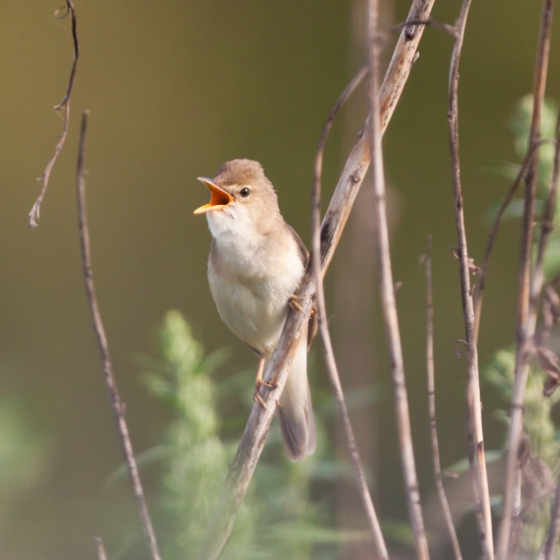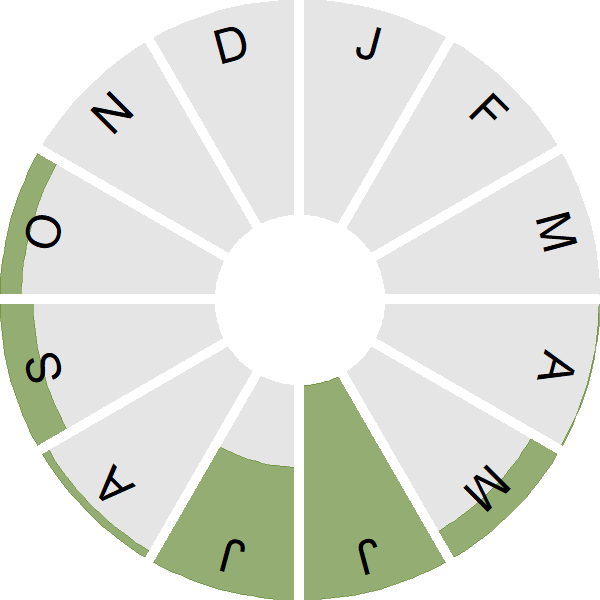Marsh Warbler

Introduction
Resembling a Reed Warbler in appearance and behaviour, this scare summer visitor and breeder is most easily identified by its complex song.
Marsh Warblers are rarely found in Britain and are absent from the island of Ireland. A small number of individuals occur on passage each year, mostly on the eastern coasts of England and Scotland, and in England, a dwindling number stays to breed. There has been an eastward shift in the distribution of the remaining breeding pairs in recent years. The Marsh Warbler has been on the UK Red List since 1996.
Marsh Warblers favour scrubby, grassland and reedbed habitats. The species largely breeds in central, northern and eastern Europe, and winters in south-east Africa. Males frequently incorporate songs from other species, including those encountered on their wintering grounds, when singing during the breeding season.

Key Stats
Identification
Songs and Calls
Song:
Status and Trends
Conservation Status
Population Change
The breeding population at the start ofthe twentieth century may have been over 180 pairs, with numbers beginning to decline after 1950 (Kelsey et al. 1989). During the 1970s there were around 60–80 pairs of Marsh Warbler breeding in the UK, with the stronghold in Worcestershire (Kelsey et al. 1989). Declines occurred during the 1980s and 1990s and breeding in Worcestershire was last confirmed in 1995, with small numbers subsequently continuing to breed elsewhere in the UK, mostly at east coast locations (Bell et al. 2021). The five-year mean figure reported to the Rare Breeding Birds Panel for the period 2015–2019 was just 10 breeding pairs (Eaton et al. 2021).
Distribution
Singing Marsh Warblers apperar rather unpredictably and few sites are occupied in successive seasons. The breeding-season distribution map shows a strong bias towards the east coast of Britain, reflecting this species' easterly direction of arrival from its East African wintering grounds.
Occupied 10-km squares in UK
2007/08–10/11
or view it on Bird Atlas Mapstore.
2008–11
or view it on Bird Atlas Mapstore.
European Distribution Map
Distribution Change
Up until the late 1980s, Marsh Warbler distribution was very different, with a regular population in southwest England between Worcestershire and Somerset. From a high of 180 pairs the population dwindled to extinction over 80 years. Subsequently, a small population appeared in Kent but that too disappeared, with disturbance and egg-collecting thought to have contributed to their demise.
Change in occupied 10-km squares in the UK
from 1968–72 to 2008–11
or view it on Bird Atlas Mapstore.
Seasonality
Marsh Warbler is a rare summer visitor, arriving in mid May. Additionally small numbers are encountered on autumn migration in September.
Weekly pattern of occurrence
The graph shows when the species is present in the UK, with taller bars indicating a higher likelihood of encountering the species in appropriate regions and habitats.

Movement
Britain & Ireland movement
Foreign locations of birds ringed or recovered in Britain & Ireland
Dots show the foreign destinations of birds ringed in Britain & Ireland, and the origins of birds ringed overseas that were subsequently recaptured, resighted or found dead in Britain & Ireland. Dot colours indicate the time of year that the species was present at the location.
- Winter (Nov-Feb)
- Spring (Mar-Apr)
- Summer (May-Jul)
- Autumn (Aug-Oct)

European movements
EuroBirdPortal uses birdwatcher's records, such as those logged in BirdTrack to map the flows of birds as they arrive and depart Europe. See maps for this species here.
The Eurasian-African Migration Atlas shows movements of individual birds ringed or recovered in Europe. See maps for this species here.
Biology
Productivity and Nesting
Nesting timing
Egg measurements
Clutch Size
Survival and Longevity
Survival is shown as the proportion of birds surviving from one year to the next and is derived from bird ringing data. It can also be used to estimate how long birds typically live.
View number ringed each year in the Online Ringing Report.
Lifespan
Biometrics
Wing length and body weights are from live birds (source).
Wing length
Body weight
Ring Size
Classification, names and codes
Classification and Codes
- Order: Passeriformes
- Family: Acrocephalidae
- Scientific name: Acrocephalus palustris
- Authority: Bechstein, 1798
- BTO 2-letter code: MW
- BTO 5-letter code: MARWA
- Euring code number: 12500
Alternate species names
- Catalan: boscarla menjamosquits
- Czech: rákosník zpevný
- Danish: Kærsanger
- Dutch: Bosrietzanger
- Estonian: soo-roolind e. putke-roolind
- Finnish: luhtakerttunen
- French: Rousserolle verderolle
- Gaelic: Ceileiriche-fèithe
- German: Sumpfrohrsänger
- Hungarian: énekes nádiposzáta
- Icelandic: Seljusöngvari
- Irish: Ceolaire Corraigh
- Italian: Cannaiola verdognola
- Latvian: purva kaukis
- Lithuanian: karkline nendrinuke
- Norwegian: Myrsanger
- Polish: lozówka
- Portuguese: felosa-palustre
- Slovak: trsteniarik obycajný
- Slovenian: mocvirska trstnica
- Spanish: Carricero políglota
- Swedish: kärrsångare
- Welsh: Telor Gwerni
Research
Causes of Change and Solutions
Causes of change
Habitat changes including fragmentation and natural succession may have made some sites less suitable in the Worcestershire stronghold, but as some suitable habitat remained it is likely that other factors also contributed which may have included disturbance from birdwatchers and egg collectors; additionally the isolation of the population meant that immigration would have been limited and the population would have been more at risk from chance events affecting a large proportion of birds during winter or on migration (Kelsey et al. 1989; Bell et al. 2021). The UK remains at the edge of the species' breeding range and therefore the small remaining population remains vulnerable even though suitable habitat exists.
More Evidence
More evidence from Conservation Evidence.com
Partners
Citing BirdFacts
If you wish to cite particular content in this page (e.g. a specific value) it is best to use the original sources as linked in the page. For a more general citation of the whole page please use: BTO (20XX) BirdFacts Species: profiles of birds occurring in the United Kingdom. BTO, Thetford (www.bto.org/birdfacts, accessed on xx/xx/xxxx).

